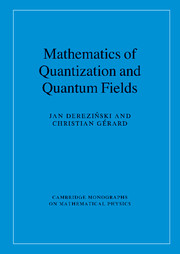Book contents
- Frontmatter
- Contents
- Introduction
- 1 Vector spaces
- 2 Operators in Hilbert spaces
- 3 Tensor algebras
- 4 Analysisin L2 (ℝd)
- 5 Measures
- 6 Algebras
- 7 Anti-symmetric calculus
- 8 Canonical commutation relations
- 9 CCR on Fock space
- 10 Symplectic invariance of CCR in finite-dimensions
- 11 Symplectic invariance of the CCR on Fock spaces
- 12 Canonical anti-commutation relations
- 13 CAR on Fock spaces
- 14 Orthogonal invariance of CAR algebras
- 15 Clifford relations
- 16 Orthogonal invariance of the CAR on Fock spaces
- 17 Quasi-free states
- 18 Dynamics of quantum fields
- 19 Quantum fields on space-time
- 20 Diagrammatics
- 21 Euclidean approach for bosons
- 22 Interacting bosonic fields
- References
- Symbols index
- Subject index
19 - Quantum fields on space-time
- Frontmatter
- Contents
- Introduction
- 1 Vector spaces
- 2 Operators in Hilbert spaces
- 3 Tensor algebras
- 4 Analysisin L2 (ℝd)
- 5 Measures
- 6 Algebras
- 7 Anti-symmetric calculus
- 8 Canonical commutation relations
- 9 CCR on Fock space
- 10 Symplectic invariance of CCR in finite-dimensions
- 11 Symplectic invariance of the CCR on Fock spaces
- 12 Canonical anti-commutation relations
- 13 CAR on Fock spaces
- 14 Orthogonal invariance of CAR algebras
- 15 Clifford relations
- 16 Orthogonal invariance of the CAR on Fock spaces
- 17 Quasi-free states
- 18 Dynamics of quantum fields
- 19 Quantum fields on space-time
- 20 Diagrammatics
- 21 Euclidean approach for bosons
- 22 Interacting bosonic fields
- References
- Symbols index
- Subject index
Summary
In this chapter we describe the most important examples of (non-interacting) relativistic quantum fields. We will use extensively the formalism developed in Chap. 18.
Most textbook presentations of this subject start from the discussion of representations of the Poincaré group. They stress that the most fundamental quantum fields are covariant with respect to this group. In our presentation the Poincaré covariance is a secondary property. The property that we emphasize more is the Einstein causality of fields. In the mathematical language this is expressed by the fact that observables belonging to causally separated subsets of space-time commute with one another. This property can be true even when there is no Poincaré covariance, e.g. due to the presence of an external (vector) potential in a curved space-time.
The chapter is naturally divided in two parts. In the first part we consider the flat Minkowski space and in the second an arbitrary globally hyperbolic manifold. In both cases we discuss the influence of an external (classical) potential and a variable mass. In the Minkowski case, we discuss separately the Poincaré covariance, which holds if the potential is zero and mass is constant.
The quantization consists of two stages. In the first stage one introduces the CCR or CAR algebra describing the observables of the system. The underlying phase space is the space of solutions of the corresponding equation defined on the space-time. This space is equipped with a bilinear or sesquilinear form, which leads to the appropriate CCR or CAR.
- Type
- Chapter
- Information
- Mathematics of Quantization and Quantum Fields , pp. 512 - 554Publisher: Cambridge University PressPrint publication year: 2013

